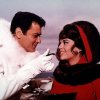Someone Like You
Posted on December 13, 2002 at 5:17 am
C+| Lowest Recommended Age: | Mature High Schooler |
| Profanity: | Strong language for PG-13 |
| Alcohol/ Drugs: | Characters drink and smoke, including use of alcohol to deaden feelings |
| Violence/ Scariness: | Some emotional tension |
| Diversity Issues: | Male-female issues |
| Date Released to Theaters: | 2001 |
Animal Husbandry,” a wry and witty book about a single woman’s efforts to understand men, has become “Someone Like You” a generic looking-for- love-in-all-the-wrong-places romance with plot twists that were tired back in the days of Sandra Dee and Bobby Darrin.
Ashley Judd, once again adding more heart and star power to a movie than it deserves, plays Jane Goodale (sounds like Jane Goodall, the chimp expert, get it?), a booker for a television talk show hosted by Diane (Ellen Barkin, looking a little washed out but always fun to watch). The people booked on the show are called “gets,” and ambitious Diane tells Jane that what she wants on her show is “the un-get-able get” the elusive guest that everyone wants but no one has.
Meanwhile, Jane is looking for a “get” of her own, a man who will love her as much as she loves him. But that seems really un-get-able. If she isn’t looking for love in all the wrong places, she is certainly looking in most of them. Ray Brown (Greg Kinnear), Diane’s new producer, seems like The One, and Jane is blissful, until he gets cold feet just as they are about to move in together. She ends up having to sublet a room from Eddie (“X-Men’s” Hugh Jackman). His womanizing provides the foundation for her emerging theory of male behavior. For example, when she asks him if it isn’t complicated when he begins dating the roommate of a woman he had recently dated, he says, “It’s never complicated for me.” Jane decides that men are genetically determined to act like bulls that refuse to service a cow a second time. Men are always looking for the “new cow.”
Jane’s best friend Liz (Marisa Tomei) persuades her to write a magazine column about the theory, under a pseudonym. Suddenly, everyone is talking about it and everyone, especially Diane, wants to interview the author. Ray tells Jane that he wants to get back together. Eddie turns out to be not heartless but recovering from a broken heart. If you have ever seen or even heard about any movie ever made, you know where it all leads.
So the only question is how much fun it is on the way to the happy ending, and the answer is: mildly. Judd delivers everything she can, and she makes Jane’s yearning to love as well as to be loved very poignant. Jackman, out of his Wolverine X-Men outfit turns out to clean up very nicely indeed, and makes a likable leading man. The dialogue is above average, and director Tony Goldwyn has some good ideas, but the plot twists are below average. This is especially clear in the last 15 minutes, which seem like a desperate attempt to think of any way to end it, and just don’t work at all.
Parents should know that the movie features sexual references and situations and some very strong language for a PG-13. Characters drink and smoke, and there are scenes in a bar. Drinking is shown as a solace for pain. Boxes of condoms and a diaphragm that has not been used for a while are shown for comic effect.
Families who see this movie should talk about the foolish choices made by Jane, Ray, and Eddie. Jane is so in love with the idea of love that she does not expect Ray to say that he loves her before they become intimate. She does not really know him when they have sex, and yet she expects him not just to know her but to love her. Jane and Liz think they have a problem figuring out men, but the problem is in understanding themselves. Eddie uses indiscriminate sex as a way of warding off intimacy. Ray is not able to be honest with himself or with the women in his life. None of them seem to have any sense of how enduring love grows, though the conclusion does suggest that it is more likely to grow between people who begin with emotional intimacy and get that on firm ground before moving on to other kinds.
Families who see this movie should look for Ashley Judd’s mother, country singer Naomi Judd, in a brief role as a make-up artist. And families who enjoy this movie will also enjoy “Pillow Talk” with Doris Day and Rock Hudson and Judd’s performance in “Where the Heart Is.

